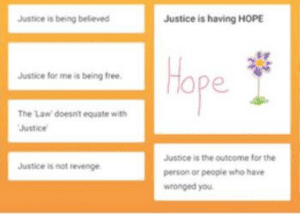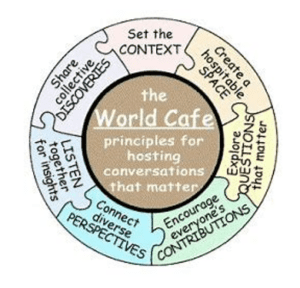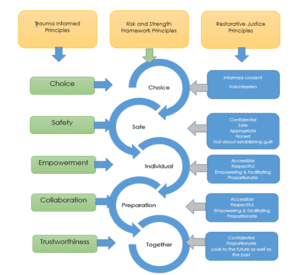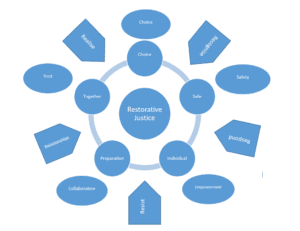Why we need to bring together trauma-informed and restorative justice principles to improve people’s experience of the justice system
Community Justice Scotland’s restorative justice project lead Rachael Moss explains why a move to blend these approaches should be explored to provide more safe and appropriate services.
Individuals’ negative experiences of justice are well-documented and have included reports of people feeling re-traumatised, having no voice and let down by the process.[1]
Court has even been referred to as a ‘theatre of shame’ in one report, forcing people harmed to re-live their experience of abuse, with some survivors enduring accidental meetings with the accused in court.
When we ask survivors what justice means, research shows that being believed contributes to their perceptions that justice has been achieved, irrespective of the outcome of any criminal proceedings.[2] In addition, see Figure 1. [3]
Figure 1. Justice is personal to the individual

Does this not make you think about the term ‘justice’ and what that actually means to people who experience harm? Also, how organisations could strive to work together to develop safe and robust mechanisms for individuals to choose how to address harm and its lasting impact by designing a justice process they define and not continuing with what the system prescribes? This doesn’t take away the need for a justice system – it’s about looking at improving it through more trauma-informed, person-centred action.
Restorative Justice (RJ) is a process of supported contact between a person harmed and a person responsible for causing harm. RJ takes on various formats, from direct contact such as face-to-face meetings, indirect contact, for example letter writing, or restorative approaches. These can include resolving conflict in educational settings or addressing secondary victimisation from systems.
RJ offers the potential for individuals to achieve a number of benefits already backed up by research evidence.
Persons harmed can experience:
- less fear of re-victimisation
- reduced feelings of revenge
- fewer symptoms of post-traumatic stress
- increased levels of satisfaction, when comparing their experience to the traditional justice process.
—
Scottish Government strategies and visions (e.g. Vision for Justice in Scotland (2022), NHS Education for Scotland – Vision for Trauma Informed Practice, Public Health Scotland: Strategic Plan (2020-23))have similar aims – to promote well-being, recovery and safety, reduce re-traumatisation and further harm across communities. So how can RJ support these aims?
This article admittedly presents more questions than answers, but I think that’s a good thing, as it offers a platform for exploration, innovation and collaboration on an agenda I think we all agree on – how the justice system and those who work in it can become more trauma-informed and responsive to all individuals in Scotland?
Being trauma-informed is about understanding how trauma exposure affects a person’s neurological, biological, psychological and social development.
Recent research on risk and mitigation strategies used by RJ facilitators in the UK and abroad, has provided the following recommendations for policy and practice to keep people safe: [4]
- RJ should be based on the assessment of individual people and cases, as opposed to types of people, offence or case
- Risk assessment and mitigation should focus on the RJ process and the unique needs of individual people
- Risk assessment of serious harm and reoffending is the duty of criminal justice agencies (e.g. social work or police)
- Multi-agency working is key to an RJ process, but it should be led by the person harmed and managed by the facilitators
- The preparation stage of an RJ process is a key measure in identifying and mitigating risk. The more sensitive and complex a case, the more time should be allocated to pre-meetings
- High quality training and experience are required for the facilitation of sensitive and complex cases and co-facilitation is recommended
See mitigation and risk in restorative justice for more detail.
RJ and trauma-informed principles have many complimentary factors and the risk and mitigation research paper helped guide my thinking into the exploration of a trauma-informed RJ risk and strengths framework.
By fusing together trauma informed and restorative justice principles I’ve come up with ways to support the development of a risk and strengths framework. This will hopefully strengthen our ability to provide safe and appropriate services that people can access, that reduce re-victimisation and support recovery.
I include the ‘5 Rs’ of trauma-informed practice into RJ development and delivery in Scotland. These are: Realising how common the experience of trauma and adversity is, Recognising the different ways that trauma can affect people, Responding by taking account of the ways that people can be affected by trauma to support recovery, opportunities to Resist re-traumatisation and offer a greater sense of choice, control, and empowerment, recognising the central importance of Relationships. See Figure 3. and how this could contribute to the development of:
- a risk and strengths framework for RJ
- safe and legal information sharing for RJ
- high quality training in RJ in collaboration with experts with lived and professional experience
I offer these tools as a starting point for collaboration, so we can begin to explore how we continue to reduce some of the negative impacts people who’ve been exposed to trauma experience when they access the justice system.
Early this year I will lead a research project to complete a series of ‘world cafés’ with experts with lived and professional experience, to develop a trauma-informed risk and strengths framework for RJ.
‘World café is a restorative approach used to facilitate group conversations where everyone is valued, included, respected and given a voice. Moving away from traditional focus groups, this method creates a safe environment that mimics a café. I look forward to hosting these in the new year and welcome anyone to get in touch who wants to have a conversation.
Figure 2. World Café Guidelines

Figure 3. Fusion of trauma informed and restorative justice principles


[1] Thomson, L., (2017). Review of Victim Care in the Justice Sector in Scotland. The Crown Office and Procreator Fiscal Service Review of Victim Care in the Justice Sector in Scotland.pdf (copfs.gov.uk)
[2] Brooks-Hay et al (2019) Justice Journeys: Informing Policy and Practice Through Lived Experience of Victim-Survivors of Rape and Serious Sexual Assault
[4] Shapland et al (2022) risk and mitigation for restorative justice
